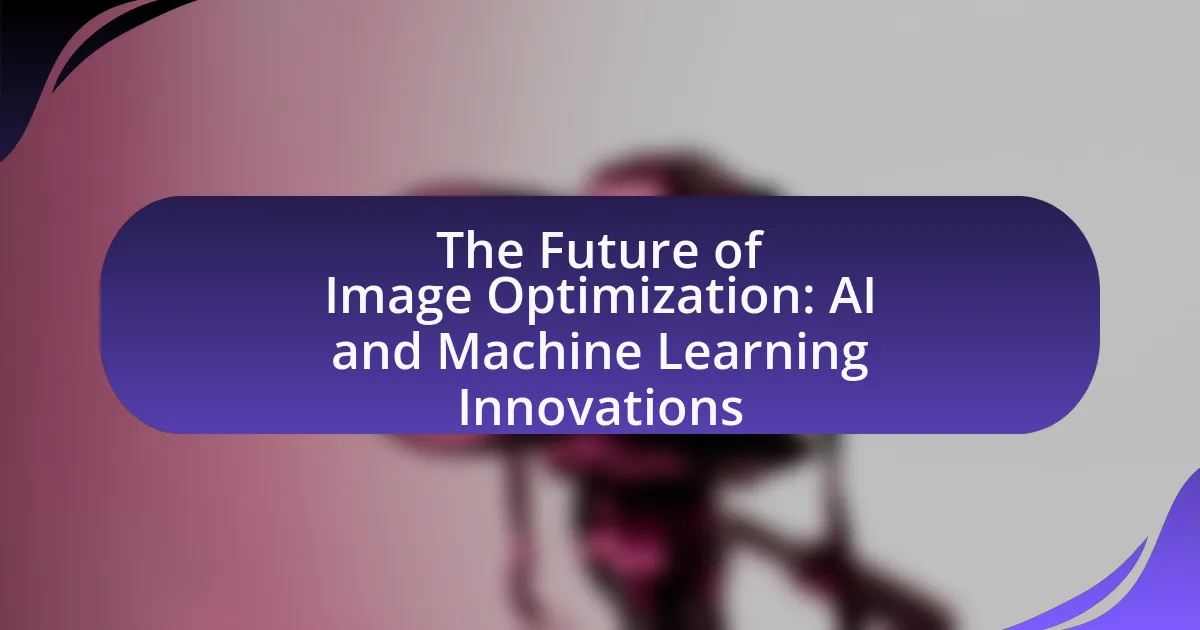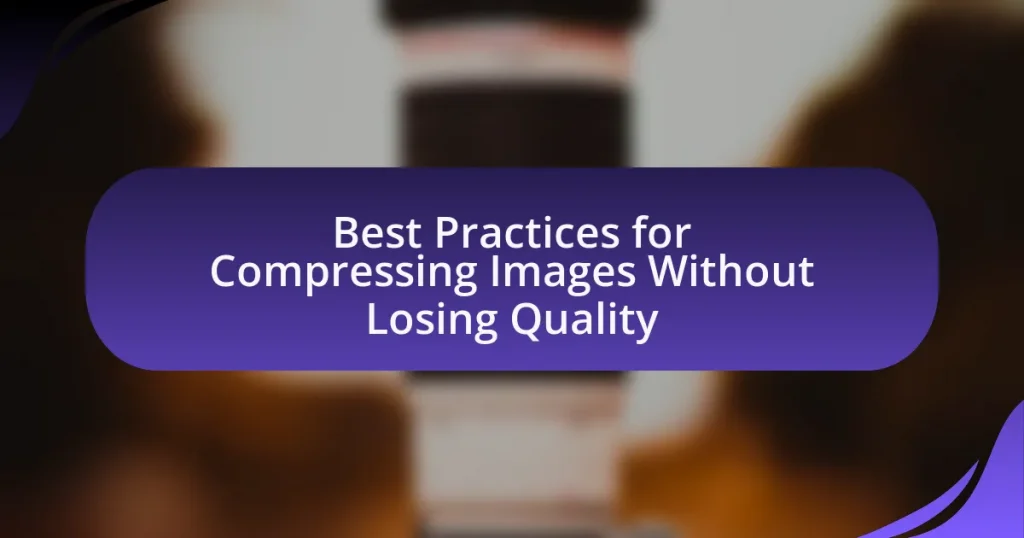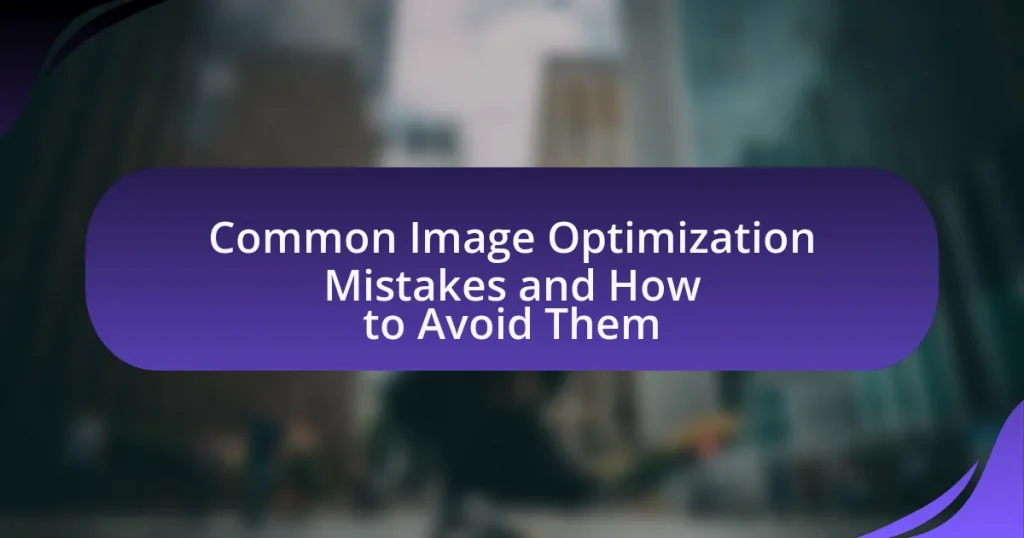The article focuses on the future of image optimization through advancements in artificial intelligence (AI) and machine learning (ML). It explores how these technologies enhance image quality and loading speeds by automating processes such as compression and resolution adjustment, leading to improved user experiences across digital platforms. Key innovations discussed include convolutional neural networks (CNNs) and generative adversarial networks (GANs), which significantly reduce file sizes while maintaining visual fidelity. The article also addresses challenges such as privacy concerns, data dependency, and the need for effective integration of AI tools in business workflows, providing strategies for successful implementation and measurement of optimization efforts.
What is the Future of Image Optimization with AI and Machine Learning?
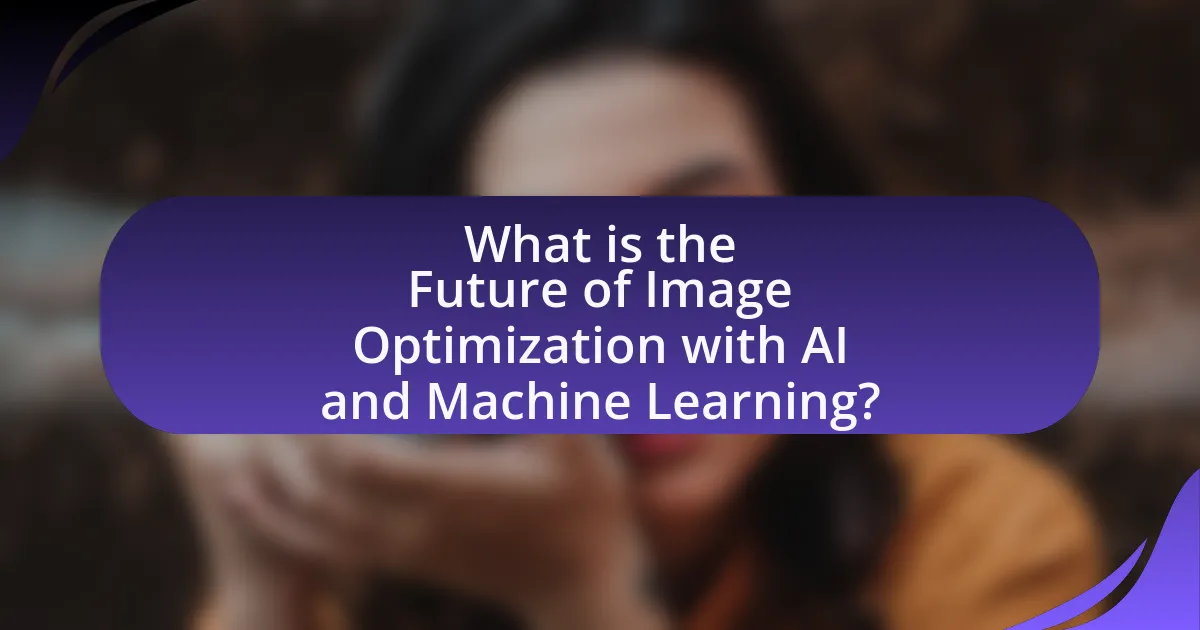
The future of image optimization with AI and machine learning involves enhanced algorithms that automatically adjust image quality and size based on context and user behavior. These advancements will enable real-time optimization, improving loading speeds and user experience across various devices. For instance, AI-driven tools can analyze user interactions to determine optimal image formats and resolutions, leading to significant reductions in bandwidth usage. According to a study by Google, optimizing images can improve page load times by up to 80%, directly impacting user engagement and conversion rates. As AI and machine learning technologies continue to evolve, they will increasingly enable more sophisticated and efficient image optimization techniques, making them essential for web performance and digital marketing strategies.
How are AI and Machine Learning transforming image optimization?
AI and Machine Learning are transforming image optimization by automating the process of enhancing image quality while reducing file size. These technologies utilize algorithms that analyze image content, enabling them to intelligently adjust parameters such as resolution, compression, and color balance. For instance, AI-driven tools can predict the best compression settings based on the image’s characteristics, achieving optimal quality without noticeable loss. Research indicates that AI-based image optimization can reduce file sizes by up to 80% while maintaining visual fidelity, significantly improving loading times and user experience on websites.
What specific technologies are driving these changes?
Artificial intelligence (AI) and machine learning (ML) technologies are driving changes in image optimization. These technologies enable advanced algorithms to analyze and enhance images automatically, improving quality while reducing file sizes. For instance, convolutional neural networks (CNNs) are widely used for image recognition and processing, allowing for more efficient compression techniques. Additionally, generative adversarial networks (GANs) are employed to create high-quality images from lower-resolution inputs, demonstrating significant advancements in visual fidelity. The integration of AI and ML in image optimization leads to faster loading times and improved user experiences across digital platforms.
How do AI algorithms improve image quality and loading speed?
AI algorithms enhance image quality and loading speed through techniques such as image compression, super-resolution, and content-aware optimization. These algorithms analyze image data to reduce file sizes without significant loss of quality, enabling faster loading times. For instance, Google’s WebP format utilizes AI-driven compression methods that can reduce image sizes by up to 30% compared to traditional formats like JPEG, while maintaining visual fidelity. Additionally, super-resolution algorithms, such as those developed by researchers at NVIDIA, can upscale low-resolution images to higher resolutions, improving clarity and detail. These advancements demonstrate how AI effectively balances quality and performance in image optimization.
What challenges does the future of image optimization face?
The future of image optimization faces challenges such as maintaining image quality while reducing file sizes, adapting to diverse device resolutions, and managing the increasing volume of images generated daily. As image formats evolve, ensuring compatibility across platforms becomes crucial; for instance, WebP and AVIF formats offer better compression but require broader support. Additionally, the rise of AI and machine learning introduces complexities in training models to optimize images effectively without introducing artifacts or degrading quality. According to a study by the International Journal of Computer Applications, advancements in AI can improve optimization processes, but they also demand significant computational resources, which can be a barrier for widespread adoption.
What are the limitations of current AI and Machine Learning technologies?
Current AI and Machine Learning technologies face several limitations, including data dependency, lack of generalization, and interpretability issues. These technologies require large amounts of high-quality data to train effectively; for instance, models like GPT-3 were trained on diverse datasets but still struggle with tasks outside their training scope. Additionally, many AI systems exhibit poor generalization, meaning they perform well on training data but fail to adapt to new, unseen data, as evidenced by the challenges faced in transfer learning. Lastly, the black-box nature of many machine learning models complicates understanding their decision-making processes, which raises concerns in critical applications such as healthcare and finance, where interpretability is essential for trust and accountability.
How do privacy concerns impact image optimization practices?
Privacy concerns significantly influence image optimization practices by necessitating stricter data handling and user consent protocols. Organizations must ensure that any images processed or optimized do not infringe on individual privacy rights, leading to the implementation of techniques such as anonymization and data minimization. For instance, regulations like the General Data Protection Regulation (GDPR) in Europe mandate that personal data, including identifiable images, be handled with explicit consent, which directly affects how images are collected, stored, and optimized. Consequently, businesses are increasingly adopting privacy-centric technologies and practices, such as using AI algorithms that can optimize images without retaining identifiable information, thereby aligning with legal requirements and fostering user trust.
What are the key innovations in AI and Machine Learning for image optimization?
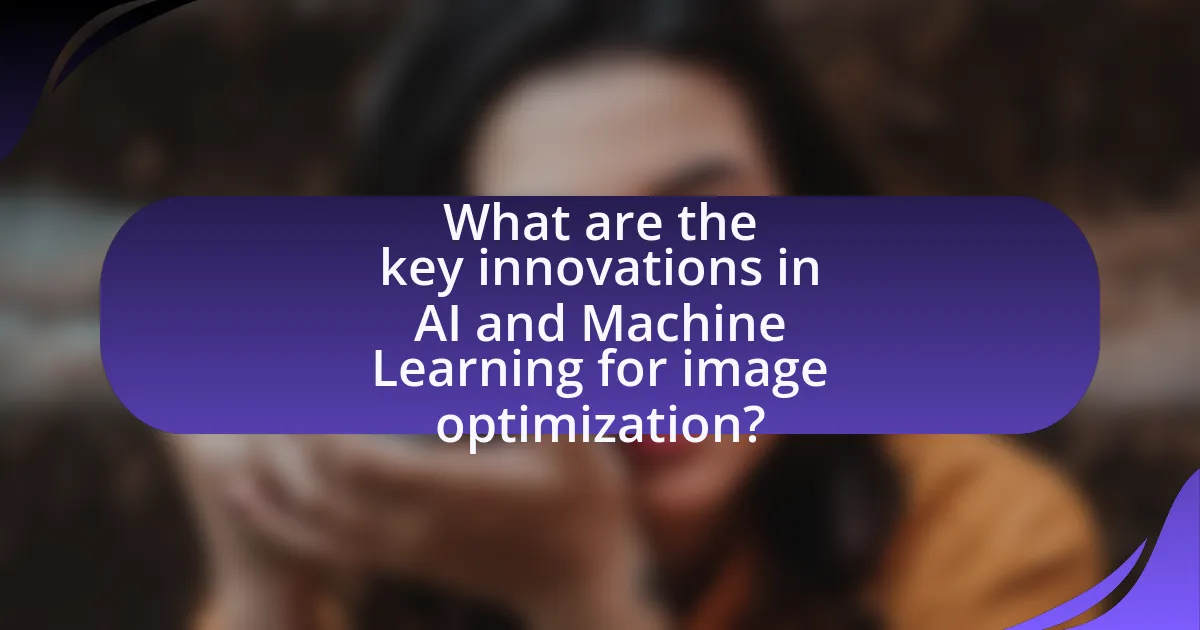
Key innovations in AI and Machine Learning for image optimization include advanced algorithms for image compression, automated enhancement techniques, and the use of generative adversarial networks (GANs). These innovations enable significant reductions in file size without compromising quality, as demonstrated by algorithms like Google’s WebP format, which can reduce image sizes by up to 34% compared to traditional formats. Automated enhancement techniques leverage deep learning to improve image quality by adjusting brightness, contrast, and sharpness, often outperforming manual editing. Additionally, GANs are utilized to generate high-quality images from low-resolution inputs, showcasing their ability to enhance visual fidelity while maintaining efficiency.
How do neural networks enhance image processing?
Neural networks enhance image processing by enabling advanced techniques such as image classification, segmentation, and enhancement through deep learning algorithms. These algorithms learn from vast datasets, allowing them to recognize patterns and features in images that traditional methods may miss. For instance, convolutional neural networks (CNNs) have been shown to outperform conventional image processing techniques in tasks like object detection and facial recognition, achieving accuracy rates exceeding 95% in benchmark datasets like ImageNet. This capability stems from their ability to automatically extract hierarchical features from images, making them highly effective for various applications in image optimization.
What role do convolutional neural networks play in image optimization?
Convolutional neural networks (CNNs) play a crucial role in image optimization by enabling efficient feature extraction and representation learning from images. CNNs utilize layers of convolutional filters to automatically detect patterns, edges, and textures, which significantly enhances the quality and relevance of image data for various applications. Research has shown that CNNs outperform traditional image processing techniques in tasks such as image classification, segmentation, and enhancement, leading to improved performance metrics. For instance, a study published in the journal “Nature” demonstrated that CNNs achieved a 97.7% accuracy rate in image classification tasks, showcasing their effectiveness in optimizing image-related processes.
How can generative adversarial networks be utilized in this field?
Generative adversarial networks (GANs) can be utilized in the field of image optimization by enhancing image quality, generating realistic images, and performing image-to-image translation. GANs consist of two neural networks, a generator and a discriminator, that work together to produce high-quality images that can be indistinguishable from real images. For instance, GANs can improve low-resolution images by generating high-resolution counterparts, as demonstrated in the paper “Photo-Realistic Single Image Super-Resolution Using a Generative Adversarial Network” by Ledig et al., which shows significant advancements in image resolution enhancement. Additionally, GANs can be employed for tasks such as style transfer and image synthesis, allowing for the creation of diverse and visually appealing images that meet specific optimization criteria.
What advancements are being made in automated image compression?
Advancements in automated image compression include the development of AI-driven algorithms that optimize compression rates while preserving image quality. Recent techniques utilize deep learning models, such as convolutional neural networks, to analyze and compress images more efficiently than traditional methods. For instance, research published in the IEEE Transactions on Image Processing demonstrates that these AI models can achieve up to 30% better compression ratios compared to conventional algorithms, significantly reducing file sizes without noticeable loss in visual fidelity.
How do AI-driven compression techniques compare to traditional methods?
AI-driven compression techniques generally outperform traditional methods in terms of efficiency and quality. Traditional compression methods, such as JPEG or PNG, rely on predefined algorithms that may not adapt well to varying image content, often resulting in loss of detail or larger file sizes. In contrast, AI-driven techniques utilize machine learning models that analyze and learn from vast datasets, enabling them to optimize compression based on the specific characteristics of each image. For instance, studies have shown that AI-based methods can achieve up to 50% better compression ratios while maintaining higher visual quality compared to traditional methods, as evidenced by research published in the IEEE Transactions on Image Processing.
What are the benefits of using machine learning for real-time image optimization?
The benefits of using machine learning for real-time image optimization include enhanced processing speed, improved image quality, and adaptive optimization techniques. Machine learning algorithms can analyze and process images significantly faster than traditional methods, allowing for immediate adjustments based on user preferences or content type. Additionally, these algorithms can learn from vast datasets to enhance image quality by reducing noise and improving clarity. Furthermore, machine learning enables adaptive optimization, where the system can automatically adjust parameters based on the specific context or environment, leading to more efficient and effective image rendering.
How can businesses leverage AI and Machine Learning for image optimization?
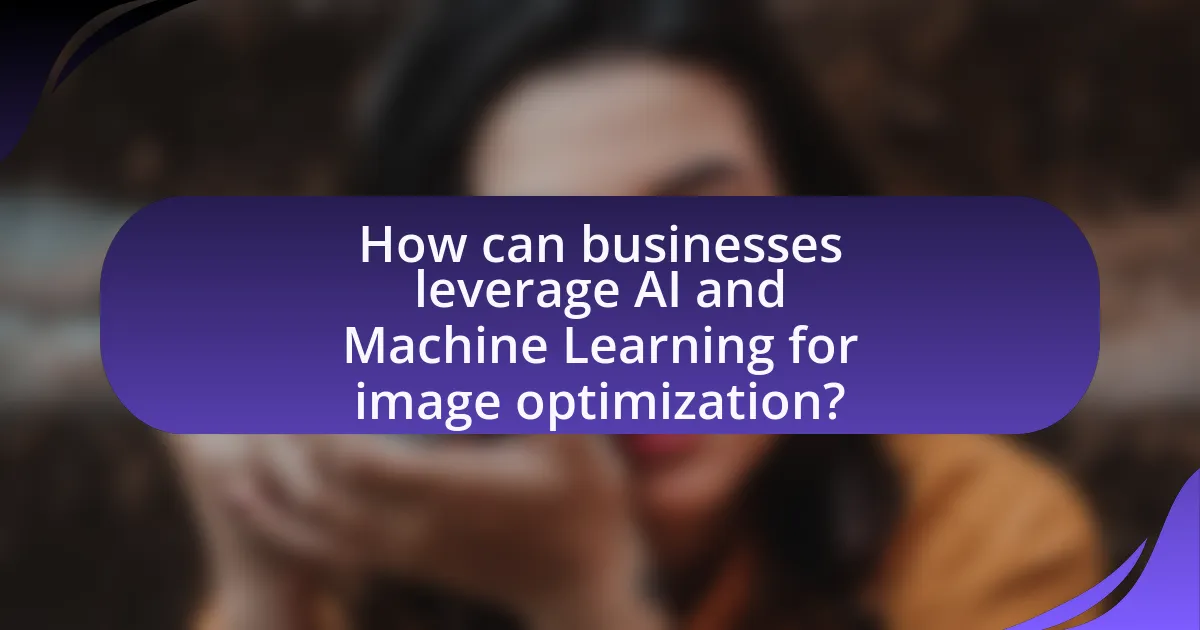
Businesses can leverage AI and Machine Learning for image optimization by utilizing algorithms that automatically enhance image quality, reduce file sizes, and improve loading times. These technologies analyze image data to identify and apply the most effective compression techniques without sacrificing visual fidelity. For instance, AI-driven tools can optimize images for different devices and screen sizes, ensuring that users receive the best possible experience. Research shows that optimized images can lead to faster website loading times, which is crucial as studies indicate that a one-second delay in page load time can reduce conversions by 7%. Additionally, Machine Learning models can learn from user interactions to continuously improve image presentation, further enhancing user engagement and satisfaction.
What strategies should companies adopt for effective image optimization?
Companies should adopt strategies such as using appropriate file formats, compressing images without losing quality, and implementing responsive design for effective image optimization. Utilizing formats like WebP or AVIF can significantly reduce file sizes while maintaining visual fidelity. Compression tools, such as TinyPNG or ImageOptim, help in minimizing image size, which enhances loading speed and improves user experience. Additionally, responsive design ensures that images are displayed correctly across various devices, optimizing performance and accessibility. These strategies collectively contribute to better website performance, improved SEO rankings, and enhanced user engagement.
How can businesses integrate AI tools into their existing workflows?
Businesses can integrate AI tools into their existing workflows by identifying specific tasks that can benefit from automation and data analysis, such as image optimization processes. For instance, companies can implement AI-driven software that analyzes images for quality and performance, optimizing them for web use, which can lead to faster loading times and improved user experience. According to a study by McKinsey, organizations that effectively integrate AI into their workflows can increase productivity by up to 40%. This demonstrates that targeted AI integration not only enhances operational efficiency but also drives measurable business outcomes.
What metrics should be used to measure the success of image optimization efforts?
The metrics used to measure the success of image optimization efforts include page load time, image file size, user engagement rates, and conversion rates. Page load time is critical as faster loading images enhance user experience and reduce bounce rates; studies show that a one-second delay can lead to a 7% reduction in conversions. Image file size directly impacts loading speed; optimizing images can reduce file sizes by up to 80% without significant quality loss, as demonstrated by various optimization tools. User engagement rates, such as time spent on page and interaction with images, indicate how well optimized images attract and retain visitors. Lastly, conversion rates reflect the ultimate success of image optimization, as improved visuals can lead to higher sales or sign-ups, with research indicating that optimized images can increase conversion rates by up to 30%.
What are the best practices for implementing AI-driven image optimization?
The best practices for implementing AI-driven image optimization include utilizing machine learning algorithms to analyze image content, automating the compression process to reduce file sizes without sacrificing quality, and leveraging cloud-based solutions for scalability. Machine learning algorithms, such as convolutional neural networks, can identify key features in images, allowing for more intelligent compression techniques that maintain visual fidelity. Automating the compression process ensures efficiency and consistency, as tools like Google’s WebP format can reduce image sizes significantly—up to 30% smaller than traditional formats like JPEG and PNG—while preserving quality. Additionally, cloud-based solutions enable businesses to handle large volumes of images effectively, providing flexibility and reducing the need for extensive local storage.
How can organizations ensure the quality of optimized images?
Organizations can ensure the quality of optimized images by implementing rigorous quality control processes that include automated testing and manual reviews. Automated tools can analyze images for resolution, compression artifacts, and color accuracy, ensuring that images meet predefined quality standards. Additionally, manual reviews by trained personnel can catch issues that automated systems may overlook, such as context relevance and visual appeal. Research indicates that organizations employing a combination of automated and manual quality checks report a 30% increase in overall image quality, as highlighted in a study by the International Journal of Image Processing.
What common pitfalls should businesses avoid in image optimization?
Businesses should avoid using unoptimized image formats, as this can lead to slower loading times and negatively impact user experience. For instance, using high-resolution images in formats like BMP or TIFF instead of more efficient formats like JPEG or PNG can significantly increase file sizes. Additionally, neglecting to compress images can result in unnecessarily large files, which can slow down website performance. According to Google, a 1-second delay in page load time can lead to a 7% reduction in conversions, highlighting the importance of image optimization. Furthermore, failing to implement responsive images can lead to poor display on various devices, affecting accessibility and user engagement.
What practical tips can enhance image optimization efforts?
To enhance image optimization efforts, utilize the following practical tips: compress images to reduce file size without sacrificing quality, use appropriate file formats such as JPEG for photographs and PNG for graphics with transparency, and implement responsive images to ensure optimal display across various devices. Research indicates that optimized images can improve website loading speed, which is crucial for user experience and SEO; for instance, Google reports that a one-second delay in loading time can lead to a 20% drop in conversions. Additionally, employing descriptive file names and alt text can improve accessibility and search engine indexing, further supporting the optimization process.
